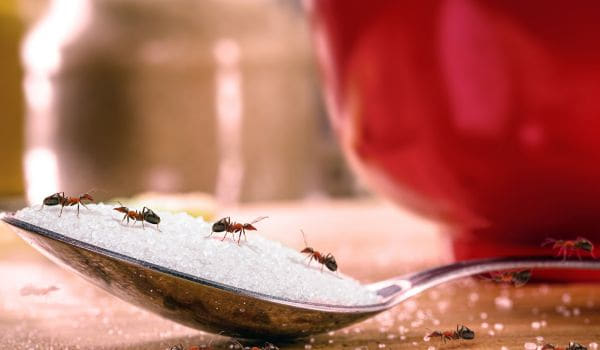The presence of black ants in the kitchen is not only an unsightly nuisance but also poses potential risks and inconveniences that warrant prompt attention. These industrious insects are drawn to food sources, and their infiltration into the kitchen can lead to contamination of food supplies, making them unsafe for consumption. Beyond the health concerns, black ants can disrupt the overall hygiene of the kitchen environment, creating an unappealing space for daily activities. Moreover, if left unaddressed, ant infestations can escalate, causing structural damage as the pests seek out nesting sites. Therefore, it becomes imperative to understand the significance of tackling black ant infestations early on to safeguard both the health and the integrity of the kitchen space.
Identifying the Black Ants

Characteristics of Black Ants
Black ants, prevalent household pests, exhibit unique characteristics that aid in their identification. Measuring between 1/16 to 1/8 inch, these ants typically sport a dark coloration, often black or dark brown. Their segmented bodies, distinct waist, elbowed antennae, and, in certain species, noticeable mandibles set them apart. These physical traits enable efficient navigation as they forage for food, contributing to their success as adaptable scavengers.
Understanding their Behavior and Nesting Habits
Black ants are renowned for their persistent foraging patterns and efficient navigation. They follow established trails to locate and transport food back to their nests. Nests are constructed in various locations, including soil, decaying wood, or structural voids within buildings. This knowledge is crucial for targeted control, allowing individuals to disrupt ant colonies at their source, and preventing recurrent infestations.
Differentiating Black Ants from Other Common Household Pests
Distinguishing black ants from look-alikes is imperative for accurate pest management. While some ants share a similar color palette, specific features such as the pronounced waist and elbowed antennae help differentiate black ants from termites or other ant species. This understanding is pivotal in developing targeted and effective control strategies, minimizing the risk of unintentionally disrupting beneficial insects or using inappropriate treatments.
Causes of Black Ant Infestation

Common Attractants in the Kitchen
The kitchen environment harbors common attractants that entice black ants. Unsecured food items and crumbs create an abundant food source for foraging ants. Spills and residues on surfaces, along with improperly stored pet food or garbage, contribute to the allure of the kitchen, making it essential to maintain cleanliness and proper food storage practices.
Potential Entry Points for Black Ants
Identifying potential entry points is crucial for fortifying homes against black ant infestations. Gaps and cracks in windows, doors, walls, and openings around utility lines provide easy access for ants. Regular inspections and sealing of these entry points are effective preventive measures to limit ant infiltration.
Environmental Factors Contributing to Infestation
Addressing environmental factors plays a pivotal role in reducing the overall appeal of an area to black ants. Moisture or water leaks and unmanaged vegetation and landscaping can contribute to infestations. Mitigating these factors through proper maintenance and landscaping practices helps create an environment less conducive to ant activity. By addressing these aspects with targeted measures, individuals can proactively mitigate the risks and inconveniences associated with black ant infestations.
Prevention Strategies

Proper Food Storage
Sealing Food Containers
Ensuring airtight seals on food containers is paramount in preventing black ant infestations. By eliminating access to potential food sources, individuals can significantly reduce the attractiveness of the kitchen environment to these pests.
Keeping Countertops Clean
Regularly cleaning and sanitizing countertops are essential components of effective prevention. Removing food crumbs and residues promptly diminishes the incentive for black ants to forage in the kitchen, disrupting their access to nourishment.
Eliminating Entry Points
Sealing Cracks and Gaps
Identifying and sealing any cracks or gaps in windows, doors, walls, and other structural elements is a proactive step to thwart ant entry. By closing off these potential access points, individuals create a formidable barrier against the infiltration of black ants.
Repairing Damaged Screens and Windows
Damaged screens and windows offer convenient entry points for ants. Regular maintenance and prompt repairs contribute to a secure living space, reducing the risk of infestations initiated through vulnerabilities in the home’s exterior.
Maintaining Cleanliness
Regular Cleaning Routines
Establishing consistent cleaning routines is crucial for preventing black ant infestations. This includes sweeping, mopping, and wiping down surfaces regularly to remove any lingering food particles that might attract ants.
Proper Disposal of Food Scraps
The proper disposal of food scraps is essential in minimizing ant attractants. Ensuring that garbage bins have secure lids and are emptied regularly prevents the buildup of enticing odors and eliminates potential food sources for foraging ants.
Natural Remedies

Using Natural Ant Repellents
Citrus Peels
The natural oils found in citrus peels act as a deterrent for get rid of black ants in the kitchen. Placing citrus peels near entry points or known ant trails can help discourage their presence in the kitchen.
Vinegar Solutions:
Vinegar’s strong scent disrupts ant trails and serves as a natural repellent. Mixing equal parts of vinegar and water to create a cleaning solution can be effective in wiping down surfaces and deterring ants.
Plant-Based Deterrents
Mint
Mint leaves or essential oils are known to repel ants due to their strong aroma. Placing mint strategically in the kitchen or along ant-prone areas can act as a natural barrier.
Cucumber Slices
The bitter compounds in cucumber slices act as a deterrent for ants. Placing cucumber slices near entry points or potential pathways can help discourage their presence.
Implementing a combination of these prevention strategies and natural remedies provides a holistic approach to keeping black ants at bay, promoting a pest-free and hygienic kitchen environment.
Chemical Solutions
Overview of Ant Baits
How Ant Baits Work
Ant baits are designed to attract foraging ants with a tempting food source mixed with a slow-acting poison. The foragers consume the bait and bring it back to the colony, where it is shared with other ants, including the queen. This indirect method of delivery ensures the elimination of the entire colony.
Placing Ant Baits Strategically
Effective placement of ant baits is crucial for success. Identifying ant trails and placing baits along their pathways or near entry points ensures maximum exposure. It’s important to avoid using other cleaning agents or chemicals near the bait to prevent contamination and reduce its attractiveness to the ants.
Insecticide Sprays
Choosing Effective Insecticides
Selecting the right insecticide is key to addressing black ant infestations. Look for insecticides specifically formulated for ants and labeled safe for indoor use. Consider the active ingredients, such as pyrethroids, and choose products with a residual effect for prolonged control.
Proper Application for Kitchen Safety
When applying insecticide sprays in the kitchen, prioritize safety. Ensure the area is well-ventilated, and follow the manufacturer’s instructions regarding application methods and quantities. Focus on targeting areas where ants are active while minimizing exposure to food preparation surfaces.
Seeking Professional Help
When to Consider Professional Pest Control
Knowing when to seek professional pest control is crucial for efficient and management. Consider professional assistance when the infestation is extensive, persistent despite DIY efforts, or poses health and safety risks. Professionals can assess the situation and provide targeted solutions.
Choosing a Reputable Pest Control Service
When selecting a pest control service, prioritize reputable and licensed professionals. Seek recommendations, read reviews, and verify the company’s credentials. A trustworthy service conducts thorough inspections, provides transparent information on treatment options, and offers follow-up visits as needed.
Discussing Eco-Friendly Options with Professionals
Engaging in a conversation with pest control professionals about eco-friendly options is essential for those concerned about the environmental impact of chemical solutions. Many pest control companies offer eco-friendly alternatives, such as botanical insecticides or integrated pest management strategies, which prioritize minimal environmental disruption.
Regular Maintenance
Implementing Routine Inspections
Scheduled Checks
Regular inspections are a proactive approach to black ant control. Establish a schedule for inspecting key areas prone to infestations, such as the kitchen, pantry, and surrounding spaces. This allows for the early detection of ant activity and potential entry points.
Identification of Hotspots
Focus inspections on areas where ants are likely to forage or nest, including cracks, crevices, and food storage areas. Detecting ant trails and nests during routine checks enables swift intervention before the infestation escalates.
Periodic Reinforcement of Preventive Measures
Reassessing and Enhancing
Periodically reassess the effectiveness of existing preventive measures. Evaluate the condition of seals on food containers, the state of entry point repairs, and the consistency of cleanliness practices. Enhance these measures based on observations and experiences to fortify the defense against black ants.
Reapplication of Natural Deterrents
If using natural remedies, such as citrus peels or mint, consider their periodic reapplication. Natural deterrents may lose potency over time, and a regular refresh can help maintain their effectiveness in deterring ants.
Addressing New Potential Entry Points Promptly
Swift Response
Act promptly upon discovering new potential entry points for ants. Whether it’s a crack in the wall or a gap around a window, immediate attention prevents the infiltration of ants and preserves the integrity of the protective barriers in place.
Adapting Strategies
Ants are resourceful, and their behavior may change over time. Stay adaptable and modify preventive strategies based on evolving patterns or new entry points identified during routine inspections. This proactive approach ensures ongoing effectiveness.
Conclusion
Maintaining a pest-free kitchen involves a commitment to regular inspections, preventive measures, and swift responses to emerging challenges. Routine checks not only detect early signs of black ant activity but also allow for the reinforcement of existing preventive measures. Periodic enhancements to the overall strategy, along with the swift addressing of new potential entry points, create a dynamic and effective defense against black ants. By combining vigilant regular maintenance with a comprehensive approach that includes natural remedies, chemical solutions, and professional assistance when needed, individuals can create an environment that is unwelcoming to black ants.




